Solar eclipse of May 11, 2040
| Solar eclipse of May 11, 2040 | |
|---|---|
| Type of eclipse | |
| Nature | Partial |
| Gamma | −1.2529 |
| Magnitude | 0.5306 |
| Maximum eclipse | |
| Coordinates | 62°48′S 174°24′E / 62.8°S 174.4°E |
| Times (UTC) | |
| Greatest eclipse | 3:43:02 |
| References | |
| Saros | 119 (67 of 71) |
| Catalog # (SE5000) | 9597 |
A partial solar eclipse will occur on Friday, May 11, 2040. A solar eclipse occurs when the Moon passes between Earth and the Sun, thereby totally or partly obscuring the image of the Sun for a viewer on Earth. A partial solar eclipse occurs in the polar regions of the Earth when the center of the Moon's shadow misses the Earth.
Images
Related eclipses
Solar eclipses of 2040–2043
This eclipse is a member of a semester series. An eclipse in a semester series of solar eclipses repeats approximately every 177 days and 4 hours (a semester) at alternating nodes of the Moon's orbit.[1]
| Solar eclipse series sets from 2040 to 2043 | ||||||
|---|---|---|---|---|---|---|
| Ascending node | Descending node | |||||
| Saros | Map | Gamma | Saros | Map | Gamma | |
| 119 | May 11, 2040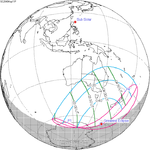 Partial |
−1.2529 | 124 | November 4, 2040 Partial |
1.0993 | |
| 129 | April 30, 2041 Total |
−0.4492 | 134 | October 25, 2041 Annular |
0.4133 | |
| 139 | April 20, 2042 Total |
0.2956 | 144 | October 14, 2042 Annular |
−0.303 | |
| 149 | April 9, 2043 Total (non-central) |
1.0031 | 154 | October 3, 2043 Annular (non-central) |
1.0102 | |
Saros 119
It is a part of Saros cycle 119, repeating every 18 years, 11 days, containing 71 events. The series started with partial solar eclipse on May 15, 850 AD. It contains total eclipses on August 9, 994 AD and August 20, 1012 with a hybrid eclipse on August 31, 1030. It has annular eclipses from September 10, 1048 through March 18, 1950. The series ends at member 71 as a partial eclipse on June 24, 2112. The longest duration of totality was only 32 seconds on August 20, 1012. The longest duration of annularity was 7 minutes, 37 seconds on September 1, 1625. The longest duration of hybridity was only 18 seconds on August 31, 1030.
| Series members 54–70 occur between 1801 and 2100: | ||
|---|---|---|
| 54 | 55 | 56 |
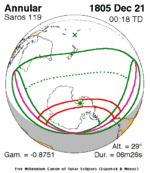 December 21, 1805 |
 January 1, 1824 |
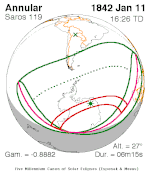 January 11, 1842 |
| 57 | 58 | 59 |
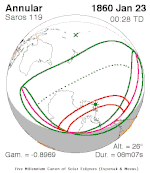 January 23, 1860 |
 February 2, 1878 |
February 13, 1896 |
| 60 | 61 | 62 |
 February 25, 1914 |
 March 7, 1932 |
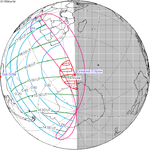 March 18, 1950 |
| 63 | 64 | 65 |
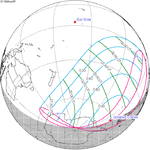 March 28, 1968 |
 April 9, 1986 |
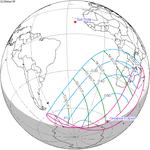 April 19, 2004 |
| 66 | 67 | 68 |
 April 30, 2022 |
 May 11, 2040 |
 May 22, 2058 |
| 69 | 70 | |
 June 1, 2076 |
 June 13, 2094 | |
References
- ^ van Gent, R.H. "Solar- and Lunar-Eclipse Predictions from Antiquity to the Present". A Catalogue of Eclipse Cycles. Utrecht University. Retrieved 6 October 2018.





